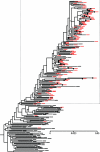Genomewide screening reveals high levels of insertional polymorphism in the human endogenous retrovirus family HERV-K(HML2): implications for present-day activity
- PMID: 16160178
- PMCID: PMC1211540
- DOI: 10.1128/JVI.79.19.12507-12514.2005
Genomewide screening reveals high levels of insertional polymorphism in the human endogenous retrovirus family HERV-K(HML2): implications for present-day activity
Abstract
The published human genome sequence contains many thousands of endogenous retroviruses (HERVs) but all are defective, containing nonsense mutations or major deletions. Only the HERV-K(HML2) family has been active since the divergence of humans and chimpanzees; it contains many members that are human specific, as well as several that are insertionally polymorphic (an inserted element present only in some human individuals). Here we perform a genomewide survey of insertional polymorphism levels in this family by using the published human genome sequence and a diverse sample of 19 humans. We find that there are 113 human-specific HERV-K(HML2) elements in the human genome sequence, 8 of which are insertionally polymorphic (11 if we extrapolate to those within regions of the genome that were not suitable for amplification). The average rate of accumulation since the divergence with chimpanzees is thus approximately 3.8 x 10(-4) per haploid genome per generation. Furthermore, we find that the number of polymorphic elements is not significantly different from that predicted by a standard population genetic model that assumes constant activity of the family until the present. This suggests to us that the HERV-K(HML2) family may be active in present-day humans. Active (replication-competent) elements are likely to have inserted very recently and to be present at low allele frequencies, and they may be causing disease in the individuals carrying them. This view of the family from a population perspective rather than a genome perspective will inform the current debate about a possible role of HERV-K(HML2) in human disease.
Figures




Similar articles
-
Human endogenous retrovirus K106 (HERV-K106) was infectious after the emergence of anatomically modern humans.PLoS One. 2011;6(5):e20234. doi: 10.1371/journal.pone.0020234. Epub 2011 May 25. PLoS One. 2011. PMID: 21633511 Free PMC article.
-
The HERV-K human endogenous retrovirus envelope protein antagonizes Tetherin antiviral activity.J Virol. 2014 Dec;88(23):13626-37. doi: 10.1128/JVI.02234-14. Epub 2014 Sep 10. J Virol. 2014. PMID: 25210194 Free PMC article.
-
Insertional polymorphisms: a new lease of life for endogenous retroviruses in human disease.Trends Genet. 2007 Jul;23(7):326-33. doi: 10.1016/j.tig.2007.05.004. Epub 2007 May 23. Trends Genet. 2007. PMID: 17524519 Review.
-
Human-specific integrations of the HERV-K endogenous retrovirus family.J Virol. 1998 Dec;72(12):9782-7. doi: 10.1128/JVI.72.12.9782-9787.1998. J Virol. 1998. PMID: 9811713 Free PMC article.
-
Human Endogenous Retroviruses Are Ancient Acquired Elements Still Shaping Innate Immune Responses.Front Immunol. 2018 Sep 10;9:2039. doi: 10.3389/fimmu.2018.02039. eCollection 2018. Front Immunol. 2018. PMID: 30250470 Free PMC article. Review.
Cited by
-
Identification of a group of Mus dunni endogenous virus-like endogenous retroviruses from the C57BL/6J mouse genome: proviral genomes, strain distribution, expression characteristics, and genomic integration profile.Chromosome Res. 2012 Oct;20(7):859-74. doi: 10.1007/s10577-012-9322-z. Epub 2012 Nov 30. Chromosome Res. 2012. PMID: 23197326 Free PMC article.
-
GREM, a technique for genome-wide isolation and quantitative analysis of promoter active repeats.Nucleic Acids Res. 2006 May 12;34(9):e67. doi: 10.1093/nar/gkl335. Nucleic Acids Res. 2006. PMID: 16698959 Free PMC article.
-
Demographic histories of ERV-K in humans, chimpanzees and rhesus monkeys.PLoS One. 2007 Oct 10;2(10):e1026. doi: 10.1371/journal.pone.0001026. PLoS One. 2007. PMID: 17925874 Free PMC article.
-
Variation in proviral content among human genomes mediated by LTR recombination.Mob DNA. 2018 Dec 18;9:36. doi: 10.1186/s13100-018-0142-3. eCollection 2018. Mob DNA. 2018. PMID: 30568734 Free PMC article.
-
Quadruplex-forming DNA sequences spread by retrotransposons may serve as genome regulators.Mob Genet Elements. 2014 Jan 1;4(1):e28084. doi: 10.4161/mge.28084. Epub 2014 Feb 4. Mob Genet Elements. 2014. PMID: 24616836 Free PMC article.
References
-
- Bieda, K., A. Hoffmann, and K. Boller. 2001. Phenotypic heterogeneity of human endogenous retrovirus particles produced by teratocarcinoma cell lines. J. Gen. Virol. 82:591-596. - PubMed
-
- Boeke, J. D., and J. P. Stoye. 1997. Retrotransposons, endogenous retroviruses, and the evolution of retroelements, p. 343-435. In J. M. Coffin, S. H. Hughes, and H. E. Varmus (ed.), Retroviruses. CSHL Press, New York, N.Y. - PubMed
Publication types
MeSH terms
Substances
Grants and funding
LinkOut - more resources
Full Text Sources
Other Literature Sources
Research Materials

